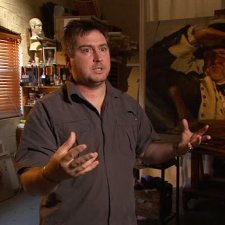Emeritus Professor Derek Denton AC (1924-2022), physiologist, was born in Launceston and graduated in medicine from the University of Melbourne in 1947. What became a pre-eminent career as a research physiologist commenced with a new discovery on kidney function in 1948, when he was appointed to the Walter and Eliza Hall Research Institute. As a Research Fellow with the National Health and Medical Research Council he set up the Ionic Research Unit in the University of Melbourne’s Department of Physiology in 1949. Between 1964 and 1970 he headed up the Howard Florey Laboratories of Experimental Physiology; and from 1971 he was founding director of the Howard Florey Institute, which became one of the world's leading medical research facilities under his leadership. Recognised internationally as an authority on the regulation of salt and water metabolism - he explained the mechanism of thirst - Denton was elected to a host of the most distinguished academies and societies worldwide, including the Royal Society, the Royal College of Physicians, the National Academy of Science (USA) and the French Academy of Sciences. He was a Fellow of the Australian Academy of Sciences and of Trinity College, University of Melbourne; and from 1978 until 1990 he was a member of the jury of the Lasker Prize, one of the world's major scientific awards. Throughout his career Denton was interested principally in genetic and learned instinctive behaviour, and how genetically determined mechanisms are regulated by chemical and hormonal changes in the body and brain; later, he turned to philosophical reflections on consciousness. His books include The Hunger for Salt (1983) and The Primordial Emotions (2005, 2006).
Artist Evert Ploeg was inspired by Denton's commitment to and passion for science. He depicted Denton behind a sheet of Perspex onto which various diagrams, notes, formulae and illustrations have been scribbled, conveying a sense of the sitter's immersion in thinking and research.
Commissioned with the assistance of funds provided by Janet Whiting AM, Philip Lukies and Antonia Syme 2016
© Evert Ploeg
Antonia Syme AM (1 portrait supported)
Philip Lukies (1 portrait supported)
Janet Whiting AM (1 portrait supported)



On one level The Companion talks about the most famous and frontline Australians, but on another it tells us about ourselves.



An interview with artist Evert Ploeg about his portrait of the Australian actor Deborah Mailman.



Visit us, learn with us, support us or work with us! Here’s a range of information about planning your visit, our history and more!